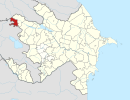
Stepanakert or Khankendi is a ghost city in the Nagorno-Karabakh region of Azerbaijan. The city was under the control and the capital city of the breakaway Republic of Artsakh prior to the 2023 Azerbaijani offensive in the region. The city is located in a valley on the eastern slopes of the Karabakh mountain range, on the left bank of the Qarqarçay (Karkar) river.

Artsakh, officially the Republic of Artsakh or the Republic of Nagorno-Karabakh, was a breakaway state in the South Caucasus whose territory was internationally recognised as part of Azerbaijan. Between 1991 and 2023, Artsakh controlled parts of the former Nagorno-Karabakh Autonomous Oblast of the Azerbaijani Soviet Socialist Republic, including its capital Stepanakert. It had been an enclave within Azerbaijan from the 2020 Nagorno-Karabakh war until the 2023 Azerbaijani offensive, when the Azerbaijani military took control over the remaining territory controlled by Artsakh. Its only overland access route to Armenia after the 2020 war was via the 5 km (3.1 mi) wide Lachin corridor, which was placed under the supervision of Russian peacekeeping forces.

Qazax District is one of the 69 districts of Azerbaijan. Located in the northwest of the country, it belongs to the Gazakh-Tovuz Economic Region. The district borders the district of Aghstafa, and the Tavush Province of Armenia. Its capital and largest city is Gazakh. As of 2020, the district had a population of 98,400.

Fuzuli is a city and the capital of the Fuzuli District of Azerbaijan.

The Nagorno-Karabakh conflict was an ethnic and territorial conflict between Armenia and Azerbaijan over the region of Nagorno-Karabakh, inhabited mostly by ethnic Armenians until 2023, and seven surrounding districts, inhabited mostly by Azerbaijanis until their expulsion during the 1990s. The Nagorno-Karabakh region was entirely claimed by and partially controlled by the breakaway Republic of Artsakh, but was recognized internationally as part of Azerbaijan. Azerbaijan gradually re-established control over Nagorno-Karabakh region and the seven surrounding districts.

There are no diplomatic relations between Armenia and Azerbaijan. The two neighboring states had formal governmental relations between 1918 and 1921, during their brief independence from the collapsed Russian Empire, as the First Republic of Armenia and the Democratic Republic of Azerbaijan; these relations existed from the period after the Russian Revolution until they were occupied and annexed by the Soviet Union, becoming the constituent republics of Soviet Armenia and Soviet Azerbaijan. Due to the five wars waged by the countries in the past century—one from 1918 to 1921, another from 1988 to 1994, and the most recent in 2016, 2020 and 2023—the two have had strained relations. In the wake of hostilities, social memory of Soviet-era cohabitation is widely repressed.
Nrnadzor is a village in the Meghri Municipality of the Syunik Province in Armenia, on the bank of the Aras River.
Minbashyly is a village in the Jabrayil district of Azerbaijan, located on Araz plain, 6 km south of the city of Jabrayil, on the right bank of Chaylag River.
Qızılhacılı is an abandoned Azerbaijani village in the Qazakh District of Azerbaijan. It has been under the occupation of Armenia since the First Nagorno-Karabakh War and is de facto administered as part of its Tavush Province. On April 19 2024, Armenia accepted to handover the village to Azerbaijan.

Aşağı Əskipara is an abandoned and uninhabited village in the Qazakh District of Azerbaijan. It is located along the border, in territory controlled by Armenia since the First Nagorno-Karabakh War. The neighboring settlement of Voskepar is located in Armenia proper. Another nearby village, Yuxarı Əskipara, is located in what is de jure an Azerbaijani exclave within Armenia, but is controlled by Armenia.
Bağanis Ayrum is a ghost village in the Qazakh District of Azerbaijan. The village was controlled by Armenia from the First Nagorno-Karabakh War until April 19 2024. On April 19 2024, Armenia accepted to handover the village to Azerbaijan.

Dashalty or Karin Tak was a village in the Shusha District of Azerbaijan, in the region of Nagorno-Karabakh. Until 2020, the village was controlled by the Republic of Artsakh. The village had an ethnic Armenian-majority population prior to the 2020 Nagorno-Karabakh war, and also had an Armenian majority in 1989.
Sofulu is a village located within the Dagh Tumas administrative-territorial unit of Jabrayil district of Azerbaijan, on the slopes of the Karabakh ridge, 18 km west of the city of Jabrayil.

The Lachin corridor is a mountain road in Azerbaijan that links Armenia and Karabakh.

Haftevan is a village in Zulachay Rural District of the Central District of Salmas County, West Azerbaijan province, Iran.
Hashtian, also romanized as Hashtīān, Hashteyān, and Hashtīyān, is a village in, and the capital of, Sumay-ye Jonubi Rural District of Sumay-ye Beradust District of Urmia County, West Azerbaijan province, Iran. The previous capital of the rural district was the village of Hovarsin.
Hovarsin is a village in, and the former capital of, Sumay-ye Jonubi Rural District of Sumay-ye Beradust District of Urmia County, West Azerbaijan province, Iran. The capital of the rural district has been transferred to the village of Hashtian.

The Armenia–Azerbaijan border is the international border between the Republic of Armenia and the Republic of Azerbaijan. Estimates of the border's length vary from 996 km (619 mi) to 1,007.1 km (625.8 mi). European routes E002 and E117 cross the border.

The military forces of Armenia and Azerbaijan have been engaged in a border conflict since 12 May 2021, when Azerbaijani soldiers crossed several kilometers into Armenia in the provinces of Syunik and Gegharkunik. Despite international calls for withdrawal from the European Parliament, the United States, and France, Azerbaijan has maintained its presence on Armenian soil, occupying at least 215 square kilometres (83 sq mi) of internationally recognized Armenian territory. This occupation follows a pattern of Azerbaijan provoking cross-border fights and instigating ceasefire violations when its government is unhappy with the pace of negotiations with Armenia.












